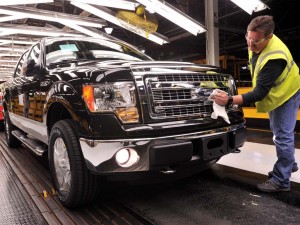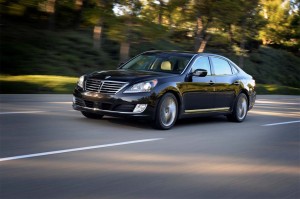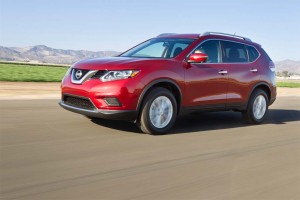
It was another "best-selling" year for the F-150 as it again captured the title of best-selling vehicle in the U.S., helping Ford to a 2% sales increase in December.
With domestic and international brands reporting solid gains in December, new vehicle sales, like the stock market, finished 2013 on an upbeat note, creating optimism about the outlook for the year to come.
While a few manufacturers have yet to report in, the industry was on track to report its best sales numbers in six years, a welcome relief after the worst industry downturn since the Great Depression. A total of about 15.5 million vehicles were purchased by U.S. motorists in 2013, and forecasts for the coming year range from IHS Automotive’s conservative 16.1 million to as much as 16.5 million or more.
Significantly, an assortment of manufacturers finished last year reporting all-time best numbers, a list that included imports such as Audi, Subaru, Hyundai and Kia. But at least a few automakers ended 2013 on a mixed note – Toyota, for one, reporting a 1.7% drop in December sales, though it was nonetheless up 7.4% for the year as a whole.
“The auto industry was a consistent bright spot in the economic recovery throughout 2013,” said Bill Fay, Toyota division group vice president and general manager, focusing on the maker’s broader gains. “We expect the economy will continue to gain strength in 2014, with car sales rising to pre-recession levels.”
Whether, in fact, the industry will reach the 17-million record set a decade ago remains to be seen, but after a brief scare last autumn, there are few signs that the car market’s momentum is slowing down. Automakers say a combination of an improving economy and job market, stable fuel prices, attractive new products and low interest rates combined to boost sales last year and are setting the table for future gains in 2014.
For December, Chrysler Group LLC reported U.S. sales increased 6%, giving the company 45 consecutive months of growth. Meanwhile, Ford reported a modest increase of 2% in December, while General Motors saw its sales fall 6% last month.
However, Audi, Jaguar, Nissan and Hyundai all reported double-digit sales increases for the final month of 2013, in part driven by aggressive marketing campaigns backed by lucrative deals.
“The combination of a strong luxury market and a dramatic increase in consumer interest in both of our brands has led Jaguar Land Rover’s U.S. business to outpace the general market with a 20% full year increase,” said Joe Eberhardt, the newly appointed president of Jaguar Land Rover North America.
There were a number of surprises in 2013 that helped fuel the strong sales growth. Among the most notable was a resurgent full-size pickup truck market buoyed by a nascent housing recovery. Detroit makers have continued to dominate the segment, none more so than Ford which again saw its big F-Series land as not only the top-selling truck, but also the best-selling vehicle overall in the American market.
For the year, that helped Ford score an overall sales increase of 10.8%. But another factor that worked in the maker’s favor, noted sales and marketing chief John Felice, was a modest increase in demand for domestic products in traditionally import-dominated coastal regions like California.
Full-year Chrysler Group sales were up 9% in 2013, compared with sales during 2012, marking the fourth-consecutive year of Chrysler Group sales growth. This will mark the last year the maker will report sales as an independent company. Following a New Year’s Day deal, it will be completely acquired by Italian alliance partner Fiat no later than Jan. 20.
Despite its December slide, GM sales rose 7% for all of 2013 and incoming CEO Mary Barra will have the advantage of having about a half-point higher market share than a year ago, a critical goal of her predecessor Dan Akerson.
“2013 was the year that GM and the auto industry put the last traces of the recession in the rearview mirror, so now we can devote our full attention to the things that matter most to customers: compelling design, world-class quality and delivering the best ownership experience in the business,” said Kurt McNeil, vice president, U.S. sales operations.
(2014 likely to be a big year for auto sales. For more, Click Here.)
Among the makers to set records last year was Nissan Motor Co., whose Nissan and Infiniti brands gained a collective 9.4% in December, and 10.5% for all of 2013.
Audi was another record-setter, a 13.5% increase helping it top its previous high for the fourth consecutive year. But its sibling Volkswagen brand didn’t fare nearly as well. Though the German brand did again top the 400,000 mark – the first time it’s done so in two consecutive years for four decades – VW struggled and lost significant momentum in the final months of 2013, ending the year with an overall 6.9% decline.
While consumers rushed back to showrooms this past year, they were faced with steadily increasing sticker prices – in part reflecting the increased content in vehicles as consumers opted for more options – but also a sign of a return to more of a seller’s market as factories strained to meet demand.
(Click Here to see the final numbers on the Fiat deal to get Chrysler.)
On the positive side, makers flooded the market with lavish sales in the final month of the year, so the estimated average transaction price for light vehicles in December increased by less than 1% or $197, to $32,890, according to Kelley Blue Book.
Also working in the favor of buyers: a rapid increase in the availability of loans to even credit-challenged buyers. And with current interest rates still low, monthly payments didn’t necessarily reflect the rise in vehicle MSRPs.
“We are optimistic heading in to 2014,” said Audi of America CEO Scott Keogh. “We are certainly projecting another record year.”
(Paul A. Eisenstein contributed to this report.)


